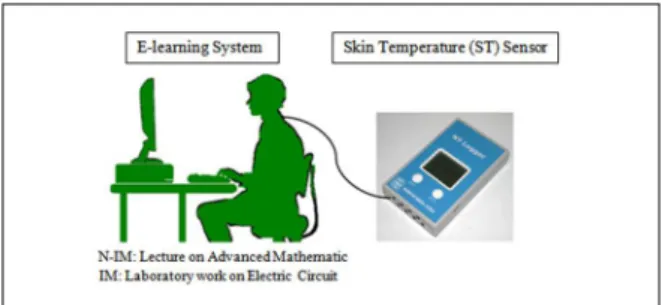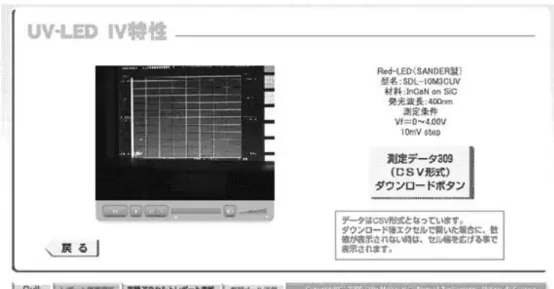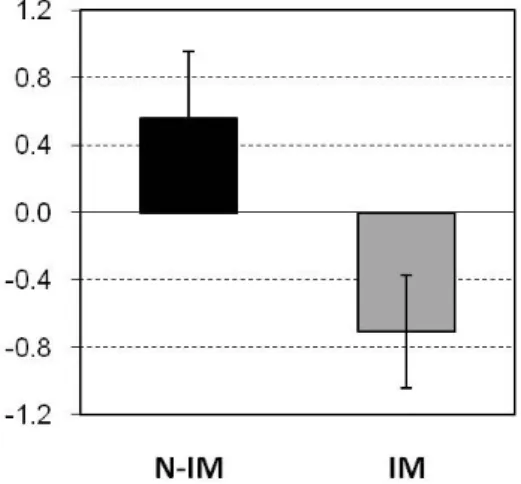Physiological Response Towards e-Learning Courses by Using Skin Temperature
全文
(2) Vol.2011-CLE-4 No.7 2011/5/13. IPSJ SIG Technical Report. 3. Different Types of Two e-Learning Materials These two e-learning materials were provided by e-learning system in e-learning Higher Education Linkage Project (eHELP)5)8)9) at Nagaoka University of Technology. A non-interactive material (N-IM) is a lecture on advanced mathematics which is a video-recorded material by universitys instructor (figure 2). The virtual laboratory work on electric circuit was used as interactive material (IM) (figure 3). Participants had to perform given tasks by instructor consecutively during learning on IM material.. Figure 3. Screenshot of interactive material. 4. Physiological Signal According to physiological signal in this experiment, skin temperature data was recorded by handheld temperature data collection (NY Logger Series N540, Nikkiso-Therm Co., Ltd.) (figure 4). These skin temperature data were collected continuously in every second until the completion of each material that is roughly about 25 minutes.. Figure 2. Screenshot of non-interactive material. Figure 4. 2. NY Logger Series N540. ⓒ 2011 Information Processing Society of Japan.
(3) Vol.2011-CLE-4 No.7 2011/5/13. IPSJ SIG Technical Report. 5. Data Analysis Due to the assumption of skin temperature could be affected by sensations6) , especially stress or concentration. It could be evaluated by facial skin temperature4) . Thus, it could be used to refer in data analysis. The skin temperature sensor was achieved in every second during the experiment which is about 25 minutes to complete each material. In order for better comparison and analysis, the skin temperature data were manipulated into an average value of every 60 seconds. Therefore, the skin temperature data in a minute time series were performed by statistical approaches including the arithmetic mean and standard error. Moreover, paired t-test analysis was performed in order to find the difference of skin temperature data against two types of e-learning materials. 6. Experimental Results and Discussion The nose skin temperature for ten participants was acquired for study. All participants were required to learn two types of e-learning material, IM and NIM material. The experiment period of each material was 25 minutes long. The experimental results were shown as below. Figure 6 shows the average value during the whole experiment period in the form of baseline corrected. In order for better comparison, the average values of both conditions have the same initial value which is 0.0. As illustrate in figure 5, the nose skin temperature of interactive and non-interactive material condition are projected and vary by time. The trend of nose skin temperature in IM condition is quite stable at the onset of experiment while another condition, NIM, trends to rise slightly. After conducting the experiment for some period of time, the significant difference was observed between both conditions (p < 0.01). In other word, N-IM condition trends to slightly change until the experiment ended. Meanwhile, nose skin temperature remarkably dropped temporarily in the IM condition (Denoted by a black arrow in the figure 5). Since the drop of nose skin temperature can indeed be used to infer stress because nose skin temperature will vary with autonomic nervous activity induced by the sensations like stress.3) Therefore, it could refer that the learners have more stress or concentration while learning on IM material than N-IM material. Due to the. Figure 5. Nose Skin Temperature of ten participants in the time series (avg. ± SE). Figure 6. 3. the average value during the experiment period. ⓒ 2011 Information Processing Society of Japan.
(4) Vol.2011-CLE-4 No.7 2011/5/13. IPSJ SIG Technical Report. various types of e-learning material also will be applied in order to investigate the significant difference of physiological signal against them. Moreover, integrating the emotional model of recognition with the physiological signals also provides an interesting field for the future research in the adaptive e-learning system.. condition of interactive material (IM) was practice-based material that learners were required to complete many tasks on time, they had to stress or concentrate on doing the given tasks. Thus, it is plausible result that the decline of nose skin temperature was observed in IM condition. However, we properly realize the fact that the emotions in human is very complicated and difficult to exactly define. Some stress in both e-learning materials could be occurred from the physiological equipment with physical contact, in other words, learners were required to attach the skin temperature sensor to the nose area. Moreover, the surrounded environment could effect to the emotion of learners. Nevertheless, the result of this study could suggest that skin temperature is considered to be another practical index for classifying the difference between interactive and non-interactive material.. References 1) Andreassi, J.L.: Psychophysiology: Human Behavior and Physiological Response, 5th Edition, Lawrence Erlbaum Associates, Reading, Massachusetts (2006). 2) Enderle, J., Blanchard, S. and Bronzino, J.: Introduction to Biomedical Engineering, 2nd Edition, Elsevier Academic Press, Amsterdam, Netherlands (2005). 3) Genno, H., Ishikawa, K., Kanbara, O., Kikumoto, M., Fujiwara, Y., Suzuki, R. and Osumi, M.: Using facial skin temperature to objectively evaluate sensations, International Journal of Industrial Ergonomics, Vol.19, No.2, pp.161 – 171 (online), DOI:DOI: 10.1016/S0169-8141(96)00011-X (1997). Kansei Engineering and Comfort. 4) Genno, H., Matsumoto, K., Suzuki, R. and Fukushima, K.: Sensory estimations using facial skin temperature, IEEE Denshi Tokyo, Vol.33, pp.212 – 214 (online), DOI:DOI: 10.1016/S0169-8141(96)00011-X (1994). Kansei Engineering and Comfort. 5) Nakahira, K.T., Suzuki, S. and Fukumura, Y.: A method of enhancing motivation in e-learning including its evaluation, Proceedings of International Conference on Computers in Education, 2008, Taipei, Taiwan, ICCE, pp.603–604 (2009). 6) Nakayama, A.: Thermal Physiology, Science and Engineering Co. (1991). 7) Nomura, S., Yamagishi, T., Kurosawa, Y., Yajima, K., Nakahira, K.T., Ogawa, N., C.M, A.I., Handri, S. and Fukumura, Y.: Anticipation of the Attitude of Students: Passive or Active Coping with e-Learning Materials Result in Different Hemodynamic Responses, Proceedings of World Conference on Educational Multimedia, Hypermedia and Telecommunications 2010, Toronto, Canada, AACE, pp.810–817 (online), available from hhttp://www.editlib.org/p/34728i (2010). 8) Yoshimi, F. and Kyuichi, M.: E-learning Program for Supporting to Create Safety and Secure Society, Journal of multimedia education research 2004, Vol.2, No.2, Japan, pp.37 – 48 (online), available from hhttp://sciencelinks.jp/j-east/article/ 200703/000020070307A0028566.phphttp://www.editlib.org/p/31661i (2006). 9) Yukawa, T., Suzuki, I. and Fukumura, Y.: A Cross-LMS Chat System and Its Evaluation, Proceedings of World Conference on Educational Multimedia, Hypermedia and Telecommunications 2009 (Siemens, G. and Fulford, C., eds.), Honolulu, HI, USA, AACE, pp.1340–1363 (online), available from hhttp://www.editlib.org/p/31661i (2009).. 7. Conclusion At present, the e-leaning development further focuses on e-leaning contents which can be adaptive to learners interests. For this purpose, physiological signals including skin temperature sensor were widely applied to measure their physiological response. Skin temperature analysis to investigate the significant difference against two types of e-learning material, interactive and non-interactive material, was studied. The nose skin temperature was obtained from skin temperature sensor during the learners was taking each material. The statistical approaches were used to analyze the collected skin temperature data. Then the significant difference in nose skin temperature between both materials was observed. 8. Future Work According to the adaptive e-learning is considered to be an important issue in e-learning society because the usage of e-learning is increasing continuously. The efficient indicators to grasp the learners physiological response or interest are required to apply in the adaptive e-learning system. We are well aware that this kind of system will be practical and applicable to real use once the researches relating to learners physiological response are totally mature and the results are sufficiently reliable. Therefore, our future work will focus on conducting more experiments and measuring physiological signals by using different equipment. The. 4. ⓒ 2011 Information Processing Society of Japan.
(5)
図



関連したドキュメント
skin core temperature of the forearm, the skin surface temperature of the instep, and peripheral blood flow of the palm were significantly higher with ISCD than with plain
The connection weights of the trained multilayer neural network are investigated in order to analyze feature extracted by the neural network in the learning process. Magnitude of
A Study on Vibration Control of Physiological Tremor using Dynamic Absorber.. Toshihiko KOMATSUZAKI *3 , Yoshio IWATA and
Optimal Stochastic Control.... Learning process in Large system...e...e.e... ILKe zli } i2 )a ) }
Theorems 1.7–1.9 are close in spirit to the extension for Glauber dynamics of Ising spins when an alternating external field is included, as carried out in Nardi and Olivieri [22],
By applying the Schauder fixed point theorem, we show existence of the solutions to the suitable approximate problem and then obtain the solutions of the considered periodic
The basic idea is that, due to (2), if a Fuchsian system has finite linear monodromy group then the solution to the isomonodromy equations, controlling its deformations, will only
The seasonal variations of the vertical structure of temperature, salinity and geostrophic velocity at latitude 6 ° N in the Bay of Bengal have been investigated, using the